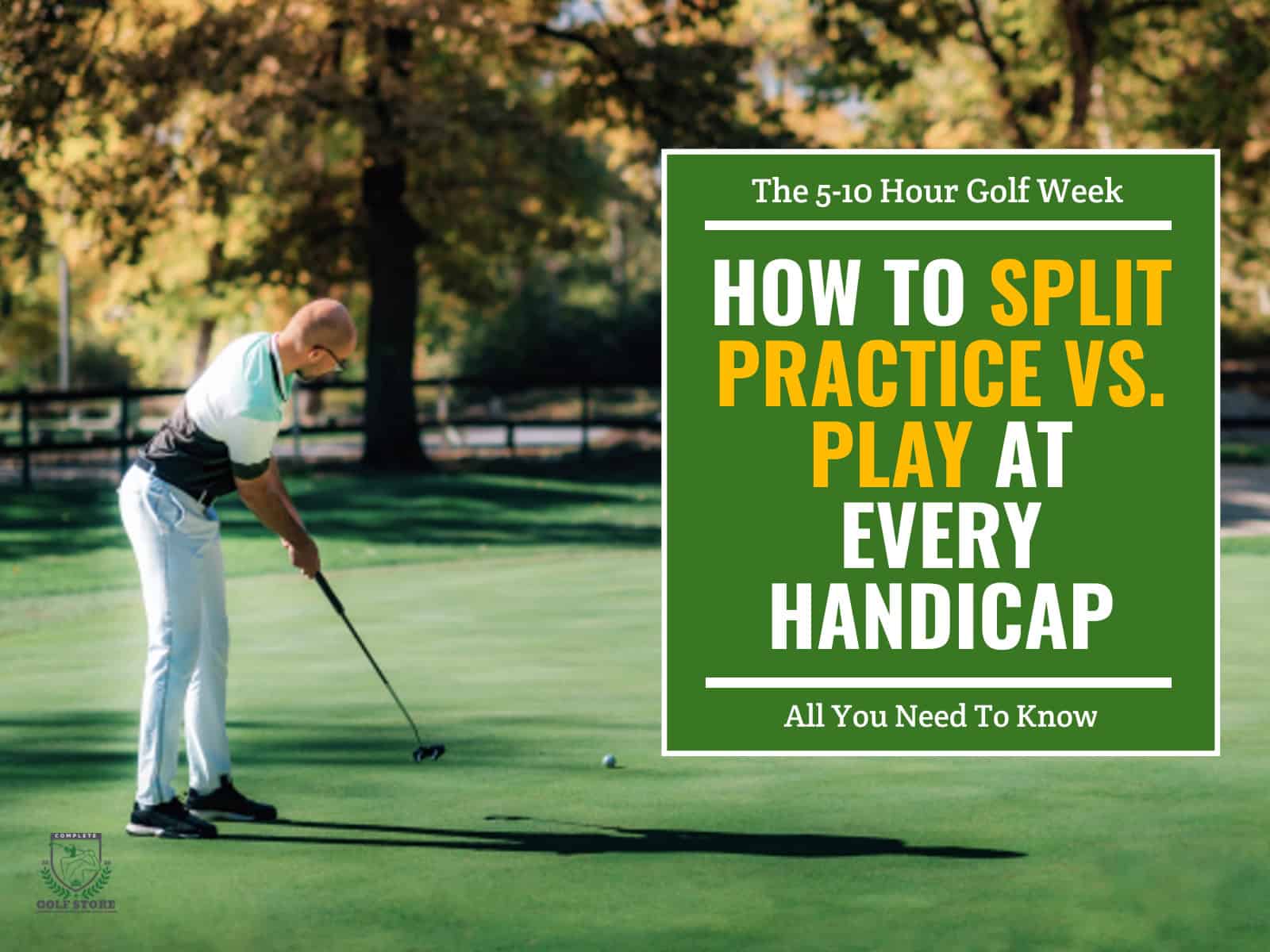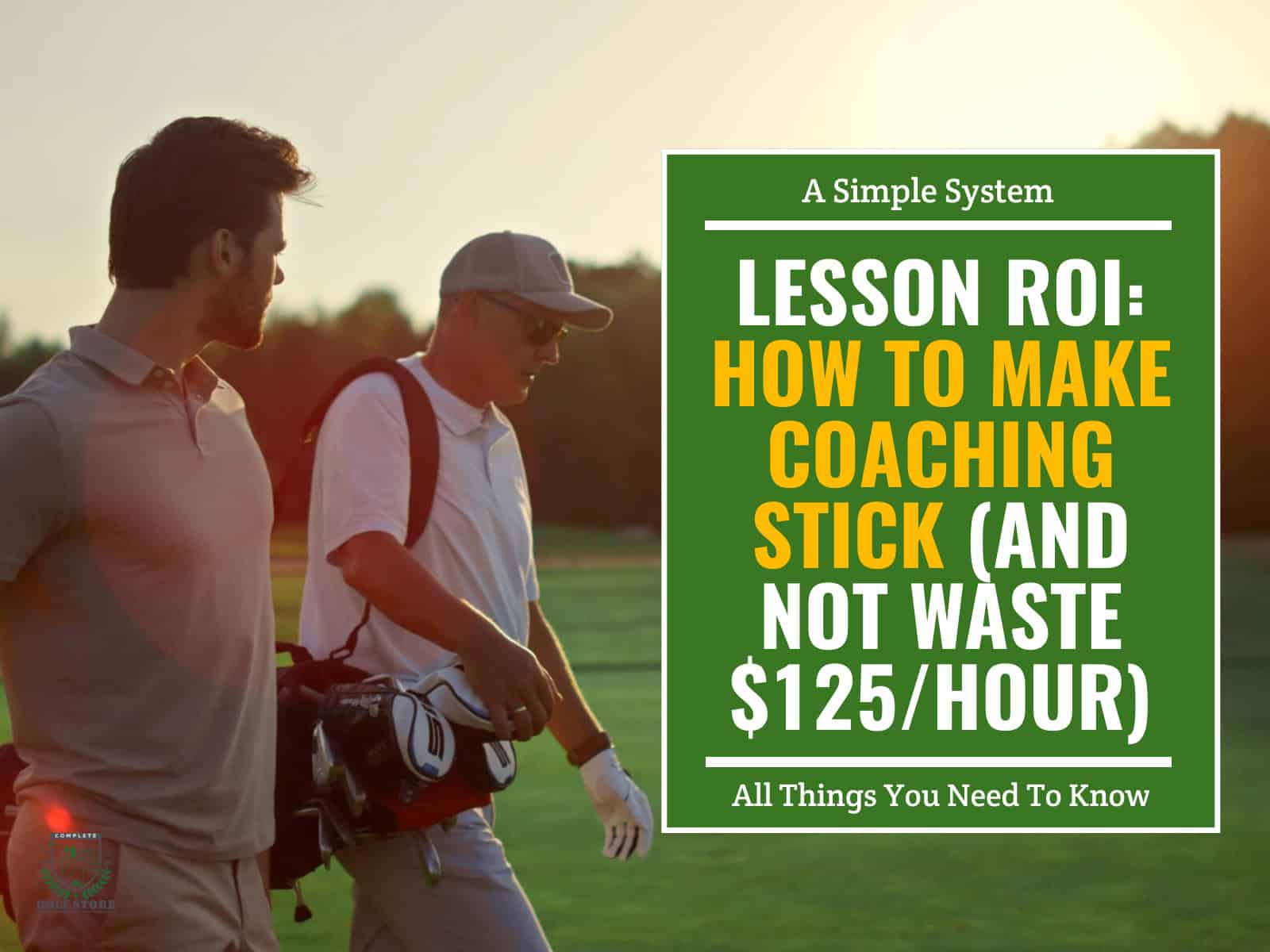Observing golf on television and participating in it are two distinct experiences. That’s why you should know a few things before hitting the golf course.
Though the sport appears to be an expensive and complicated one reserved for the wealthy, there is much more to it than meets the eye.
It is possible to become a decent golfer for a relatively small investment of time and money as an amateur.
Here, we’ll explain all you need to know before you get started with this fascinating game.
Knowing Your Equipment
Golf can appear confusing to novices and first-timers, which is understandable. Learning to play can be challenging due to the game’s steep learning curve, strict rules and regulations, and equipment demands.

Clubs
To hit the golf ball, we utilize clubs.
Three components make up a club[1]: the Head, the Shaft, and the Grip. While the laws of golf limit the design of clubs, its designers strive to construct ones that maximize the mechanics of a golfer’s swing while allowing for some range of swing error in order to produce an accurate, long, and forgiving shot.
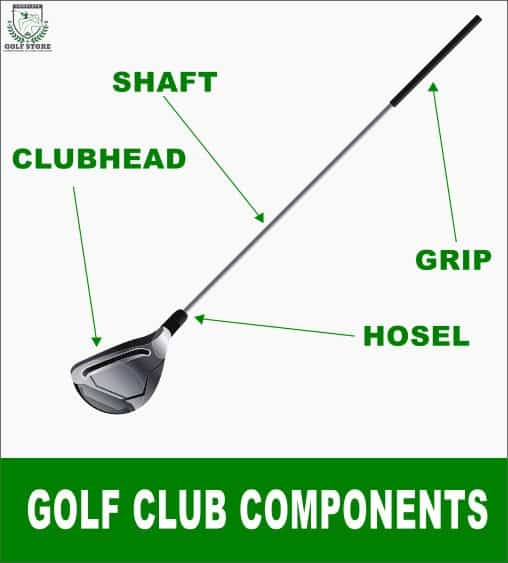
Less forgiving clubs are better suited to players who already have good swings, while those who still need to work on their swings benefit most from more forgiving clubs.
The club is used to hit the ball. The top of each club has a lance (or “grip”), while the bottom has a club head. Long clubs with a lower degree of loft are designed to drive the ball a greater distance, while those with higher lofts have a shorter distance capability.
At any one time on the course, you have complete control over the shot you take and the club you use to accomplish the shot.
Equipment is the first step in learning to play golf. There’s a lot of gear you’ll need, but your clubs take center stage. Choosing the right clubs to use might be challenging, and that’s why we have a full article dedicated to the different types, components and uses of clubs to help you out.
Woods
Woods include a driver and a set of fairway woods. Despite the fact that the heads of these clubs are no longer made of wood, they are referred to as “woods” in the industry. Titanium and steel make up the majority. In addition, woods have the largest clubheads in the game (with driver heads being the largest). They’re utilized for long-range shots that allow the player to hit the ball with maximum force.
Using woods, players can hit the ball from 200 to more than 350 yards while using a wood. A low-degree loft—the angle at which the clubface meets the shaft—is typical of woods, which have a flat bottom and a large, round head. A driver, commonly known as a 1-wood, has the lowest degree of loft, resulting in the greatest distance on shots.
The higher the number of wood, the greater the loft. Rather than hitting the ball off the tee with the driver, some golfers can switch to a higher-numbered wood if they prefer. A driver, a three-wood, and a five-wood are the most common clubs in a golfer’s bag.
You may find our comprehensive guide on 3-woods vs. drivers useful to get an additional idea.

If you want to know more about fairway woods, and the best clubs in this category, we invite you to go through our reviews of the Best Fairway Woods for High Handicappers.
Irons
Golfers utilize irons, which have metal club heads when their ball is within 200 yards of the green (for approach shots). The 9-iron has the most loft [2] of all irons (41 to 43 degrees), which are numbered 1 to 9 in order of loft, and the 1-iron is lofted at around 14 to 16 degrees, and is usually called a “driving iron”. Increasing the loft of the club results in a higher shot with a shorter distance.
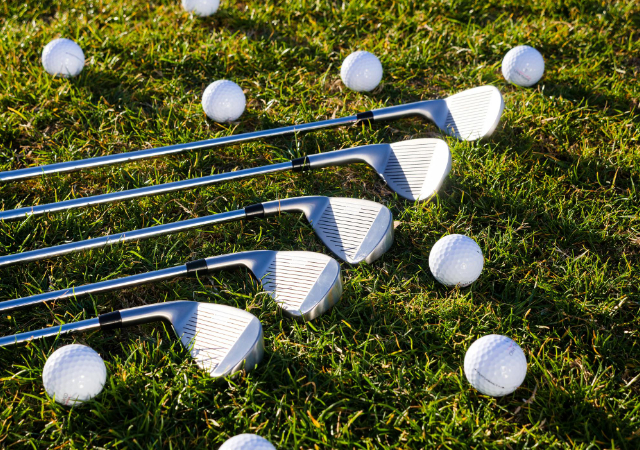
The longest irons are the 1, 2, 3, and 4-irons, which are referred to as long irons because of their low loft. They are usually used for tee shots or long approach shots.
The middle irons are utilized when the ball is around 150 to 170 yards from the hole and include irons 5 to 7. They are usually used for longer approach shots or in hillier fairways to avoid a low rise.
Short irons include the 8 and 9-irons; Due to their high loft, they can launch the ball swiftly. They have the shortest shafts and highest massed club heads. They are usually used with moderate-distance shots of 130 to 150 yards.
Only a handful of golfers own a whole set of irons numbered 1 to 9. Due to the difficulty of hitting a 1- or 2-iron, most golfers do not carry these clubs. The 3-iron through the 9-iron is the most common set in the game.
Nowadays, due to the mastery Callaway has achieved in making irons, its name has become associated with the clubs. We do have an article with the 10 Best Callaway Irons for you to know more about those.
Hybrids
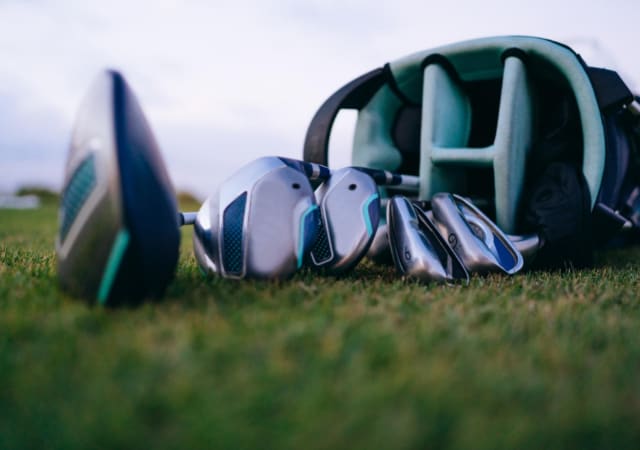
They’re the newest style of golf clubs to hit the market, and they’re proving popular. A hybrid of wood and iron, they’re both strong and light. They give you the best of both worlds without having to deal with the drawbacks of either.
If you’re just getting started, it’s a good idea to replace a few irons with hybrid clubs. This is because hybrids are much more forgiving and easier to use. You can start with our guide on the Best Hybrid Clubs for High Handicappers to choose your favorite.
For example, you may replace the 3-iron with a 19-degree lofted hybrid (or a 5-wood). A 22-degree hybrid may be used to replace the 4-iron (or you can use a 7-wood instead). The 5-iron and 6-iron can be replaced by a 25-degree and a 28-degree hybrid, respectively.
Because of the design of hybrid clubs, it’s simpler to hit the ball straight, and there’s some wiggle room if you don’t hit as straight as you would like.
Wedges
Low-distance shots can be accomplished with the help of these irons. The following subtypes exist within this category:
- Pitching wedge
Iron sets often feature pitching wedges (abbreviated PW), the longest-hitting and lowest-lofted of the wedges. The PW is an essential club for any golfer’s bag; it can be used around the green for bump-and-run shots or full shots from the fairway.
- Sand wedge
Designed primarily to facilitate hitting out of bunkers. Shorthand as SW. The sand wedge can be used in a variety of other situations: short greenside shots, flop shots, bump & run, chipping, and short pitch shots.
- Gap wedge
Your sand wedge and pitching wedge loft “gap” gets smaller as you progress through the loft progression with your set pitching wedges. The gap wedge can be utilized for full strokes, pitch shots, bump-and-run shots, and long bunker shots.
- Lob wedge
To get close to the flag while it’s on the other side of a sand trap used to be practically impossible before the lob wedge was introduced. To get the ball to stop quickly, you need to hit the shot high with a lot of backspin. Lob wedges can aid in this approach.
- Ultra lob wedge
The ultra-lob wedge has a higher loft angle of 64 degrees, which is higher than the 60 degrees of a standard wedge club. Golfers may get their ball to fly high and land softly by using this club.
Each club has a unique application in consideration. In soft hazards like sand bunkers, a sand wedge is the best tool to employ, whereas a lob wedge is best for shots taken from near-to-tall impediments like trees. Short-game shots necessitate the use of all of these types of clubs, which is why they exist.
Putters
The match is nearing its conclusion. This is a par-worthy shot, and your ball is so near that you can taste it. There is no better time than now to break out your putter.
In terms of specificity, the putter is the most important club in your arsenal. Putters come in a variety of forms and sizes, but their primary function is the same regardless of which one you choose. They are designed to drop the ball into the hole (a.k.a putting).
The putter is the club you’ll use the most, so it’s critical that you’re comfortable with the one you’ve chosen. Before you buy a putter, make sure you play with it at the store first.
Look at the whole length. Using a putter that is too lengthy for a beginner is one of the most common mistakes. To avoid this, ask someone to measure the distance between the floor and the top of your hands while your arms are at your sides. You should be aiming for a height of that kind.
Do I Need Clubs Specifically Designed for Beginners?
To summarize, the answer is no. You are free to use whatever club you like.
But there are two advantages to getting a whole beginner’s kit.
Beginner club sets typically come with everything you need to get started, including a bag. Buying a golf bag, irons, woods, driver, and putter all separately can be too pricey.
Secondly, if you buy a beginner’s set, you may rest confident that the clubs have been designed to be more forgiving than regular ones. Additional forgiving drivers and irons are available, but there are also more difficult-to-hit clubs on the market.
If you stick to beginner sets, you’ll have the tools you need to have a great time playing the game.
For a more comprehensive overview of beginner clubs, you may watch this video (8 minutes 33 seconds) from Golfbidder‘s YouTube Channel.
Golf Balls for Beginners
Golf balls should all travel in the same direction. To produce a ball that travels well when hit with a driver yet spins more when hit with a short iron or wedge is the most expensive feature. To do this, golf ball manufacturers use a multi-layer construction method[3], which is why some ball types are more expensive than others. To help you understand different ball types and constructions, we have a guide explaining the Differences Between Golf Balls.
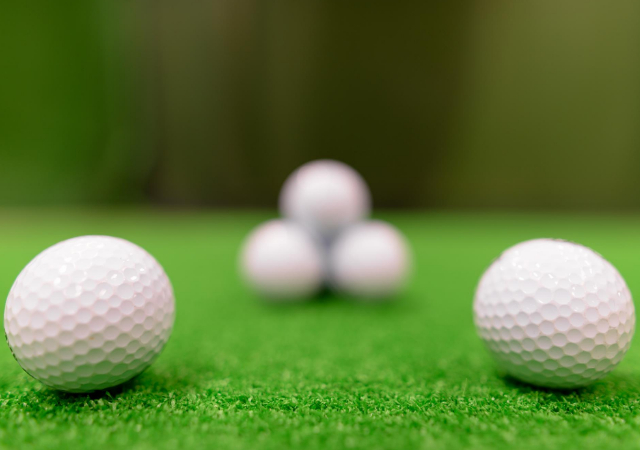
From the tee, certain balls will travel a little further. Chip shots will feel different for everyone. Instead of focusing on gaining a few additional yards off the tee, go for a ball that matches your entire game.
Golf Gloves
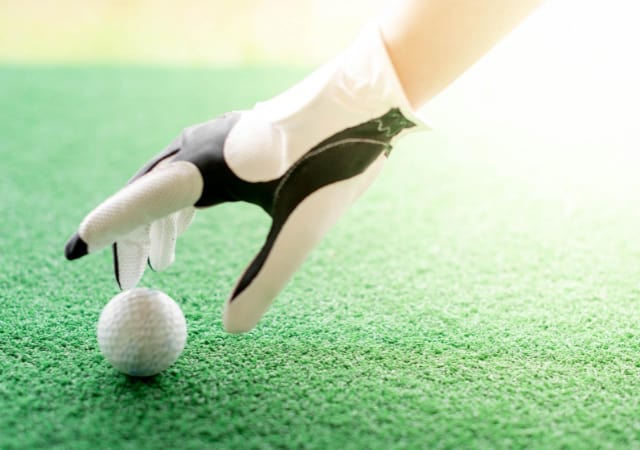
Golfers of all skill levels are encouraged to wear gloves, even if they are not necessarily required. The “lead” hand — the one at the very top of the grip — is typically wearing the glove. Right-handed players are more likely to wear one on their left hand, whereas left-handed players are more likely to do the opposite. In order to better “feel” the clubface as it makes contact with the ball, some players choose to remove their gloves during short-iron shots and putts.
Golf Bag
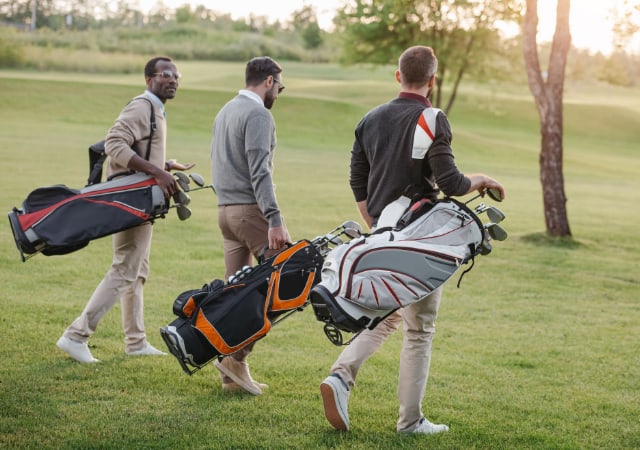
A golf bag is used to carry your clubs and other equipment around the course. Bags include numerous pockets for tees, balls, and gloves, as well as other equipment and supplies.
When playing golf, bags can either be carried, pulled by a trolley, or attached to a motorized golf cart. Hand- and shoulder-strapped golf bags are the most common; however, some can be worn as a backpack on both shoulders, and several bags feature retractable legs that allow the bag to stand upright when not in use.
The newest type is one that is versatile, and can be carried or used with a cart; check out our reviews of the Best Hybrid Golf Bags.
Golf Shoes
You won’t be needing golf shoes right away. Sneakers can suffice during your practices. Purchase golf shoes only when you’ve developed a true passion for the game.
Once you’ve developed a passion for golf and are ready to invest in proper equipment, choosing the right golf shoes becomes important. For golfers who walk the course, comfort is paramount. Our guide to comfortable golf shoes for long rounds will equip you to find the perfect pair that provides stability, support, and keeps you comfortable throughout your game.
In the end, we invite you to check out our extensive guide on the 29 Best Golf Accessories and Gadgets that you will need on the course; you’ll find everything there, from towels to shoes, divot repair tools and ball markers, etc.
Learning the Rules
Obviously, mastering the rules is a necessary component of learning how to play. While they may appear intimidating at first, do not be intimidated. Simply study the fundamentals and pick up the rest along the way.
The most effective way to learn the rules is to play against experienced players and mimic their actions. Make no apologies for asking questions or making errors. This is how we all learn.
1. Don’t move your ball
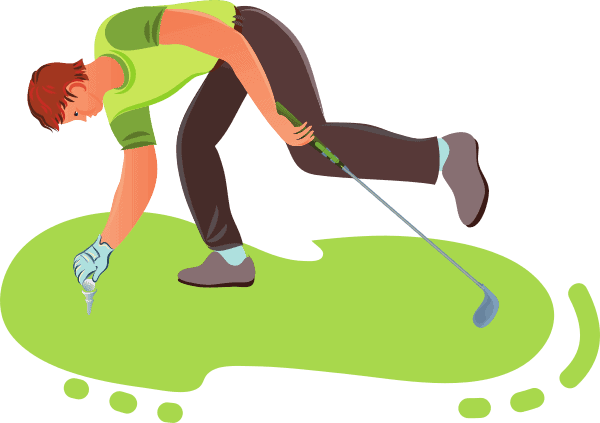
Never move your ball on the course, regardless of where you are. Unless you are prevented from doing so by a barrier, play it as-is. In addition, if you’re unsure what an obstacle is, ask the pro or an experienced golfer for clarification. Before you raise the ball off the ground on the putting green, you must record its location with a coin or a little ball marker.
2. It’s fairly reasonable to play from another hole
As long as the fairway you hit is not marked as out of bounds (white stakes or lines), you can continue to play your shot. You can playback to the hole you’re on if you don’t see any white stakes or lines. Don’t get in the way of other players on that hole. If they don’t grant you permission to go first, let them play through.
It’s a one-stroke penalty and a new shot if your ball is outside the boundaries of the course or lost and you lose the distance (the location you took the stroke at). As long as you can remember the distance from which you took your out-of-bounds (or lost) stroke, you can play a new one from the exact same location (or as close to it as you can).
As an example, if your first shot goes out of bounds, you’ll have to take a stroke penalty and play your second shot from the tee again (from as near to where you hit it as possible).
3. Only Take Three Minutes to Look for a Ball
The old rule stated that a player can take up to five minutes to find the ball before it’s deemed lost. However, the regulations have been changed, and now players have less time to find the lost balls.
Take a one-stroke penalty if you can’t find a shot after three minutes of looking. Play another shot as close to the previous position you played from as you can. You may have to drop the ball to do this—play from thereby by dropping the ball at knee height over that location (older rules stated that the ball is dropped from shoulder level). Be careful, though, as the ball must not touch any part of your body or equipment before it hits the ground!
The Objective of the Game
The objective of the game is straightforward: get your ball from the tee (the beginning point of any hole) to the green and eventually into the hole in the fewest possible shots.
The term “the hole” refers to both the physical hole designated by a flag into which the ball must be sunk and the entire region between the tee and the green. This may be regarded as a single unit of the course, with a conventional layout consisting of 18 distinct holes played in succession.
Scoring
Golf scoring can be puzzling to those new to the activity, as, unlike most other sports and activities, golf is won by the player with the lowest score.
Stroke play [4] is the most often used scoring method in golf, as it totals the number of shots taken to get the ball into each hole. This is typically done over one round (set of 18 holes) at the amateur level, although pros typically play four rounds, beginning on a Thursday and concluding on a Sunday.
The score is reported as a percentage below or above par. Par is the number of shots required to complete a hole by a competent golfer (someone playing off “scratch” or with a handicap of zero), with one shot always allowed for the tee shot and two putts always allowed (shots played on the smooth, prepared area around the hole called the green). Being under par is a positive sign since it means you completed the hole in fewer shots than anticipated.
Additionally, there are Stableford and other scoring systems, albeit these are primarily utilized in amateur golf.
This comprehensive video (5 minutes 42 seconds) from the YouTube Channel of the USGA discusses the basics of scoring in golf and glimpses what a handicap is and other scoring terminologies.
What Does Handicap Mean?
A golfer’s handicap is a number derived from their previous round’s score on the course. It is used to evaluate your performance in comparison to that of other golfers. The better you are at golf, the lower your handicap should be.
New golfers don’t get a handicap by default. You must join a USGA-approved club or local golf association to get an official handicap index for your game.
Following your initial registration with the club, you must play 54 holes in any combination of 9- or 18-hole rounds in order to receive a handicap index.
You can know everything about the handicap system by reading our dedicated article: What Is A Handicap In Golf?
Learning How to Play
The bad news is that you don’t know much about golf. However, the good news is that you probably haven’t formed many bad habits, and you’re unsure what to do. Nothing beats a positive start.

Golf Swing Basics
The golf swing consists of a series of sequential actions. 90% of new golfers get it wrong when it comes to their stance before hitting a ball. It is much easier to hit a ball if you have the proper setup.
There are three basic steps to master: grip, aim, and posture. Once you master these three swing fundamentals, you’ll be well on your way to hitting some fantastic shots.
We’ve got a bunch more tips and tricks for beginners. Interested to learn more? Check out our comprehensive article about Golf Swing Basics for Beginners.
Golf Grip
A golfer’s grip is one of the most important fundamentals to learn. The first step in learning the swing is really learning how to hold the club in your hands.

Making consistent shots is significantly more difficult if you don’t have the right grip. As a result, many players continue to employ a faulty grip because they have always done so and because they find it comfortable.
In the end, it’s up to you to choose the method that works best for you. The following are the various grips for a club you can choose from:
Strong Grip
The index fingers of both hands are centered on the shaft. You can only see your left hand’s knuckles.
Weak Grip
On the shaft, the index fingers are located to the left of the center. Your right hand’s knuckles are the only thing you can see.
Neutral Grip
The index fingers on each hand are at the shaft’s midpoint. Three knuckles should be visible on each hand.
Interlocking Grip
The right pinky and the left index finger of each hand serve as a connecting point. Instead of stacking on top of one another, these fingers intertwine with each other.
Vardon Grip
Between the index and middle fingers on the left hand is a finger called the left pinky, which acts as a link to keep both hands in close contact with one another.
Baseball Grip
The grip is held with both hands tightly clasped together, and the pinky finger serves no purpose as an anchor. As though carrying a baseball bat, place the right pinky finger close to the left index finger.
For more details, make sure you read our guide on how to hold a golf club; you’ll find anything you need about grip there. Bear in mind that your grip is a question of personal preference and convenience. Play around with different methods to see which one you prefer and feel comfortable using!
Aiming

Inexperienced golfers have a hard time focusing on the target, yet they’re actually rather adept at it. Golf is no exception to the rule that humans are inherently adept at aiming at specific targets.
Imagining yourself on a train track is an excellent visual aid. To hit a straight shot, make sure your ball and clubhead are pointing in the direction of the target. Your body is aligned with your target line, with your feet and shoulders on the left track.
Posture
A balanced swing is made possible by a good posture, which reduces the amount of effort required to hit the ball.
For the most part, beginners have excessive knee flexion and insufficient hip forward tilt. This leads to a more baseball-like stance and a propensity for the club to move above the ball.
To learn more about the basics of the swing, you may check out this video (10 minutes 56 seconds) from Data Animation.
Are you looking to level up your swinging techniques? Check out the Stress-Free Golf Swing, it might just be the one thing that’s missing in your arsenal.
Basic Shots
When it comes to golf, distance isn’t everything. In the end, everything boils down to how well you handle the course.
The top golfers are able to control the ball to shave shots off their scorecards.
For example, Tiger Woods, Phil Mickelson, and Bubba Watson are not the biggest hitters on tour, yet their ball flight and speed control allow them to avoid rough and find greens more easily than most players on tour.
Drive
Any shot that is intended to travel down the fairway and toward the green is referred to as a drive. As a result, it’s sometimes known as a “tee” shot. However, it can also be hit from the fairway.
Approach
The broadest category of golf shots is an approach shot. This attempts to land your ball on the green that begins at least 100 yards from the hole.
Pitching
To play a pitch shot, you use a lofted club to hit the ball a short distance, with a steep ascent and descent. Pitch shots are normally played within 40 to 50 yards of the green.
Putting
The putt is a well-known shot among golfers and non-golfers alike, right up there with the drive. A delicate push into the hole is the goal of this shot, which is typically taken from the green.
Making a superb putt is all about accuracy. Greens are often sloping. Thus, golfers need to be aware of the terrain. There are a ton of ways to improve your putting skills. One of which is Using Effective Golf Putting Aids that are great for beginners.
If you’re in the office and wanted to improve your putting, don’t worry because there are many Office Putting Practice Sets you can utilize in your vacant space. You can find a lot of options and opportunities to hone your skills.
Golf Lessons for Beginners
Don’t put it off any longer; begin taking lessons right away. When you first start out, the bad news is that you have little knowledge. You have a limited understanding of the game.
When it comes to starting out, there’s nothing better than having a clear goal in mind. Also, don’t wait until you’re having difficulties before seeking help. Knowing what you’re doing right, as well as what you’re doing badly, is critical. It’s best to seek the advice of a PGA professional, as they are qualified to teach the game to beginners.
A local pro who makes golf fun will help you improve your game.
There is a wealth of knowledge available on the internet, but nothing beats the personal attention you get from a trained professional who can observe exactly how you are doing things. Meeting new people and making new golfing mates are two of the many benefits of taking group introductory instruction.
7 Additional Tips
Here are some pointers for those who are just starting out in the sport:
Have Fun While Playing

There should be no greater reason to take up golf than the pursuit of happiness.
Golf is a challenging game that will certainly test your patience, but it also gives you the opportunity to share time with family and friends.
When you find yourself irritated that your swing isn’t progressing as fast as you’d like it in the early days of your golfing journey, remember to keep your smile and always seek out ways to make the game fun.
Master the Basics
It’s easy to tell a good golfer from a bad one before they’ve even hit the ball. In order to get the same results every time, they follow a pre-shot routine, which is a set sequence of actions that they perform before each shot.
Utilize Your Athleticism
Beginner golfers are prone to losing their athletic instincts as a result of becoming bogged down in the mechanics of the swing. While golf is more mental in nature than other sports, the swing is nevertheless a dynamic, athletic movement. [5]
You Should Be Able to Hit a Basic Golf Chip
Basic chipping skills are necessary for beginners, but they don’t need to be perfect, and as a novice golfer, I wouldn’t expect you to be able to accurately manage the distance of your shots. When you’re within a few feet of the hole, you want to be prepared with a reliable shot.
Holding the club lower on the handle, with a narrow stance, leaning your weight and torso toward the target, and making a basic putting action that contacts the grass is a basic golf chip technique.
We would recommend a pitching wedge for this shot and practice getting comfortable with it. You can also follow our detailed guide on How To Chip.
Know how far your clubs go
Even if you’re a beginner, it’s important to know how far your clubs can carry the ball. You may believe that you are not consistent enough to understand this, but you can.
Practice hitting a bunker shot

Beginners often struggle with sand shots. Also, keep in mind what we discussed earlier: In order to hit the ball upwards, you must first strike the ground. This means overriding any urge to raise the ball and instead, committing to hitting the sand.
Digging your feet into the sand and moving your posture forward will help you with this. For more information, check out our comprehensive guide on Hitting Out Of A Bunker.
Use Technology To Your Advantage
Last but not least, advancements in technology have affected the game to a great extent; from the processes of making clubs, balls and any other accessories to providing portable units that can help you better understand your game, both indoors and out.
For instance, on the course, you can take a portable launch monitor to help you know exactly what you’re doing right or wrong with accurate feedback after each shot you take.
Also, you can play the game indoors, even during the off-season using a golf simulator. These technological wonders combine multiple components to provide a virtual simulation of your shots and allow you to play the most popular courses in the world without stepping out.
Final Thoughts
When learning the game, remember to keep your expectations reasonable and to have fun with it.
The game can be a terrific way to relieve stress and improve your mental health in light of recent times. While having fun with friends, you can isolate yourself socially, and it’s also a fantastic way to get some fresh air and exercise.
Don’t let your lack of experience keep you from reaping the rewards.
if you still have any questions, feel free to contact us.
Thanks for reading!
References:
- Golf Club Parts – Illustrated Definitions of Golf Terms | Golf Distillery. Golf Distillery. Retrieved from https://www.golfdistillery.com/definitions/club-parts/
- What Are The Degree Loft Of Golf Clubs? Golf Monthly Magazine. Retrieved from https://www.golfmonthly.com/features/the-game/what-are-the-degree-loft-of-golf-clubs-204141
- Multi-Layer Golf Ball Technology. Golf Week. Retrieved from https://golftips.golfweek.usatoday.com/multilayer-golf-ball-technology-20246.html
- Stroke Play. USGA. Retrieved from https://www.usga.org/content/usga/home-page/rules-hub/topics/stroke-play.html
- Golf For Beginners: So You Want To Play Golf. Golf Digest. Retrieved from https://www.golfdigest.com/gallery/golf-beginners-tips



